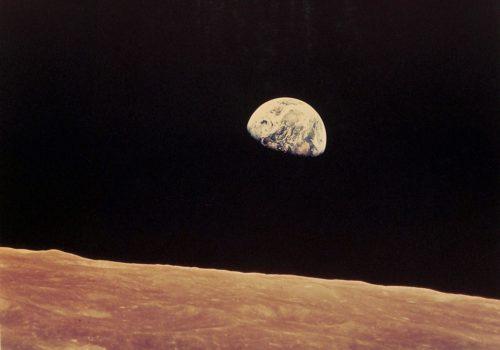The Galerie GADCOLLECTION presents 50 iconic photographs from NASA.
This is the first time that an exhibition has been organized on the subject of Earthrise and has brought together so many photographs. The GADCOLLECTION Gallery opens its exhibition on the most beautiful Earth Sunrises (from the Apollo 8 Mission to Apollo 17) as well as on the first photos of the Earth seen from Space with the imagery of the Mercury-Atlas Missions 4 and 9.
As much as the photographs of the Apollo Missions are very well documented, those of the Mercury-Atlas Missions are not at all. It was not in the concerns of NASA at the time. Several months of research were therefore necessary to identify the visual of each image.
Through a selection of 50 photographs, the exhibition offers a journey through Space.
Apollo mission (1968-1972)
From 1968 to 1972, the Apollo Missions formed a defining moment in the history of humanity, which set out to conquer space. During these missions, the astronauts indeed captured a number of stunning photographs of the Earth as seen from space, including several famous Earthrise: if these images not only provided new perspectives on our planet, they also played a role in raising environmental and scientific awareness.
One of the most famous Earthrise images was captured during the Apollo 8 mission in 1968. This photograph showed the Earth as a blue and white orb, rising above the arid lunar landscape. The image has been widely reproduced and has become an iconic symbol of the space age.
The Apollo 11 mission in 1969, meanwhile, successfully sealed the first lunar landing. Which was the main objective. The astronauts also captured images of Earth from the lunar surface. These images showed the Earth as a distant and fragile world, suspended in the blackness of space.
While the Apollo 12 and Apollo 14 missions also offered new insights into our planet, Apollo 15 was the first mission to use the Lunar Roving Vehicle, which allowed astronauts to travel much further from the lunar module and capture still images. most spectacular on Earth. Together, the latest Apollo missions (Apollo 16 and Apollo 17) have again strengthened the link between space exploration and environmental awareness.
Mercury Atlas mission (1961-1963)
The Mercury-Atlas Mission 4, launched in 1961, was one of the first missions of the United States space program. Although not as well known as some of the later missions, such as Apollo 11, it was a milestone in the development of space technology. The images captured during the Mercury-Atlas 4 mission were a milestone in the development of space technology and our understanding of the universe. Images of Earth and surrounding space offer new insights into our planet.
The Mercury-Atlas 9 Mission, launched in 1963, was one of the most significant events in the history of early space exploration. The mission marked the successful completion of a 22-orbit mission by astronaut Gordon Cooper, becoming the longest U.S. spaceflight at the time. Imagery from this mission captures the wonder, excitement and fear of a new frontier being explored. The mission marked the end of the Mercury program and paved the way for future manned missions to the Moon.
Many of these images are unknown to the public. The exhibited prints are in an extraordinary state of preservation. The colors are bright and give an impression of modernity to the subject.
Earthrise / Earth Curve
from March 9 to April 30, 2023
Galerie GADCOLLECTION
4 Rue du Pont Louis Philippe
75004 Paris
www.gadcollection.com
















